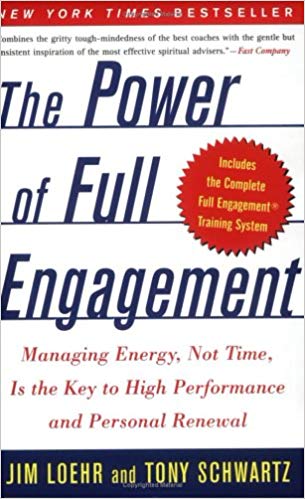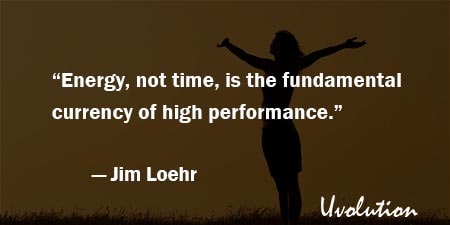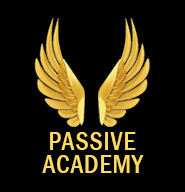The Power of Full Engagement by Jim Loehr Summary
The Book in 1 Sentences
“Every one of our thoughts, emotions and behaviors has an energy consequence, for better or for worse. The ultimate measure of our lives is not how much time we spend on the planet, but rather how much energy we invest in the time that we have.
The premise of this book—and of the training we do each year with thousands of clients—is simple enough: Performance, health and happiness are grounded in the skillful management of energy.” ~ Jim Loehr
“Energy, not time, is the fundamental currency of high performance.”
12 BIG Ideas
1. The 4 Principles of Full Engagement
2. Fully Engaging & Fully Disengaging
3. The Pulse of High Performance (Rhythms)
7. To Be Fully Engaged Emotionally
9. Extrinsic Vs Intrinsic Motivation
The Power of Full Engagement Book Summary
1. The 4 Principles of Full Engagement
“Principle 1: Full engagement requires drawing on four separate but related sources of energy:
physical, emotional, mental and spiritual.
Principle 2: Because energy diminishes both with overuse and with underuse, we must balance energy expenditure with intermittent energy renewal.
Principle 3: To build capacity we must push beyond our normal limits, training in the same
systematic way that elite athletes do.
Principle 4: Positive energy rituals—highly specific routines for managing energy—are the key to full engagement and sustained high performance.”
“To maintain a powerful pulse in our lives, we must learn how to rhythmically spend and renew energy.”
2. Fully Engaging & Fully Disengaging
“Think for a moment about the look of many long-distance runners: gaunt, sallow, slightly sunken and emotionally flat.
Now visualize a sprinter such as Marion Jones or Michael Johnson. Sprinters typically look powerful, bursting with energy and eager to push themselves to their limits.
The explanation is simple. No matter how intense the demand they face, the finish line is clearly visible 100 or 200 meters down the track.
We, too, must learn to live our own lives as a series of sprints—fully engaging for periods of time, and then fully disengaging and seeking renewal before jumping back into the fray to face whatever challenges confront us.”
“At the most practical level, our capacity to be fully engaged depends on our ability to periodically disengage.”
3. The Pulse of High Performance (Rhythms)
“Nature itself has a pulse, a rhythmic, wavelike movement between activity and rest. Think about the ebb and flow of the tides, the movement between seasons, and the daily rising and setting of the sun.
Likewise, all organisms follow life-sustaining rhythms—birds migrating, bears hibernating, squirrels gathering nuts, and fish spawning, all of them at predictable intervals. So, too, human beings are guided by rhythms.”
“The concept of maximizing performance by alternating periods of activity with periods of rest was first advanced by Flavius Philostratus (A.D. 170–245), who wrote training manuals for Greek athletes.
Russian sports scientists resurrected the concept in the 1960s and began applying it with stunning success to their Olympic athletes. Today, ‘work-rest’ ratios lie at the heart of periodization, a training method used by elite athletes throughout the world.”
4. Recovery!
“To live like a sprinter is to break life down into a series of manageable intervals consistent with our own physiological needs and with the periodic rhythms of nature. This insight first crystallized for Jim when he was working with world-class tennis players.
As a performance psychologist, his goal was to understand the factors that set apart the greatest competitors in the world from the rest of the pack. Jim spent hundreds of hours watching top players and studying tapes of their matches.
To his growing frustration, he could detect almost no significant differences in their competitive habits during points. It was only when he began to notice what they did between points that he suddenly saw a difference.
While most of them were not aware of it, the best players had each built almost exactly the same set of routines between points. These included the way they walked back to the baseline after a point; how they held their heads and shoulders; where they focused their eyes; the pattern of their breathing; and even the way they talked to themselves.”
“If nothing succeeds like success, it is equally true that nothing fails like excess. Because change requires moving beyond our comfort zone, it is best initiated in small and manageable increments.”
“Energy is simply the capacity to do work. Our most fundamental need as human beings is to spend and recover energy.”
“Periods of recovery are likewise intrinsic to creativity and to intimate connection. Sounds become music in the spaces between notes, just as words are created by the spaces between letters. It is in the spaces between work that love, friendship, depth and dimension are nurtured. Without time for recovery, our lives become a blur of doing unbalanced by much opportunity for being.”
5. Sixty-Four Ounces of Water
“Drinking water, we have found, is perhaps the most undervalued source of physical energy renewal. Unlike hunger, thirst is an inadequate barometer of need.
By the time we feel thirsty, we may be long since dehydrated. A growing body of research suggests that drinking at least sixty-four ounces of water at intervals throughout the day serves performance in a range of important ways.
Dehydrate a muscle by as little as 3 percent, for example, and it will lose 10 percent of its strength and 8 percent of its speed. Inadequate hydration also compromises concentration and coordination.”
6. Unplug The TV
“Television, for example, is one of the primary means by which most people relax and recover. For the most part, however, watching television is the mental and emotional equivalent of eating junk food.
It may provide a temporary form of recovery, but it is rarely nutritious and it is easy to consume too much.
Researchers such as Mihaly Csikszentmihalyi have found that prolonged television watching is actually correlated with increased anxiety and low-level depression.”
7. To Be Fully Engaged Emotionally
“To be fully engaged emotionally requires celebrating what the Stoic philosophers called anacoluthia—the mutual entailment of the virtues.
By this notion, no virtue is a virtue by itself. Rather, all virtues are entailed. Honesty without compassion, for example, becomes cruelty.”
“Take a moment to consider how broad a range of emotional muscles you have in your own life. In all likelihood you will discover that you have considerably more strength on one side of the spectrum than on the other.”
8. How am I That?
“Difficult and unpleasant as it may be to accept, we often feel most hostile to those who remind us of aspects of ourselves that we prefer not to see. ‘Ask someone to give a description of the personality type which he finds most despicable, most unbearable and hateful, and most impossible to get along with,’ writes Edward Whitmont, ‘and he will produce a description of his own repressed characteristics….
These very qualities are so unacceptable to him precisely because they represent his own repressed side; only that which we cannot accept within ourselves do we find impossible to live with in others.’ Think for a moment of someone you actively dislike. What quality in that person do you find most objectionable? Now ask yourself, ‘How am I that?’”
“From an energy perspective, negative emotions are costly and inefficient. Much like a gas-guzzling car, they draw down our energy stores at a rapid rate.”
9. Extrinsic Vs Intrinsic Motivation
“Purpose also becomes a more powerful source of energy when it moves from being externally to internally motivated.
Extrinsic motivation reflects the desire to get more of something that we don’t feel we have enough of: money, approval, social standing, power or even love.
‘Intrinsic’ motivation grows out of the desire to engage in an activity because we value it for the inherent satisfaction it provides.
Researchers have long found that intrinsic motivation tends to prompt more sustaining energy. A study conducted by the University of Rochester’s Human Motivation Research Group found, for example, that people whose motivation was authentic—defined as ‘self-authored’—exhibited more interest, excitement and confidence, as well as greater persistence, creativity and performance than a control group of subjects who were motivated largely by external demands and rewards.”
“In short, money may not buy happiness, but happiness may help you get rich.”
10. Specificity of Timing & Precision of Behavior
“A broad and persuasive array of studies confirms that specificity of timing and precision of behavior dramatically increase the likelihood of success.
The explanation lies once again in the fact that our conscious capacity for self-control is limited and easily depleted. By determining when, where and how a behavior will occur, we no longer have to think much about getting it done. A series of experiments have confirmed this pattern…
In perhaps the most dramatic experiment of all, a group of drug addicts were studied during withdrawal—a time when the energy required to control the urge to take drugs severely compromises their ability to undertake nearly any other task.
As part of the effort to help them find employment post-rehabilitation, one group was asked to commit to writing a short résumé before 5:00 P.M. on a particular day. Not a single one succeeded.
A second group was asked to complete the same task, but also to say exactly when and where they would write the résumé. Eighty percent of that group succeeded.”
11. The Power of Rituals
“We use the word ‘ritual’ purposefully to emphasize the notion of a carefully defined, highly structured behavior. In contrast to will and discipline, which require pushing yourself to a particular behavior, a ritual pulls at you.
Think of something as simple as brushing your teeth. It is not something that you ordinarily have to remind yourself to do. Brushing your teeth is something to which you feel consistently drawn, compelled by its clear health value. You do it largely on automatic pilot, without much conscious effort or intention.
The power of rituals is that they insure that we use as little conscious energy as possible where it is not absolutely necessary, leaving us free to strategically focus the energy available to us in creative, enriching ways.”
“All great performers rely on positive rituals to manage their energy and regulate their behavior.” And: “The more exacting the challenge and the greater the pressure, the more rigorous our rituals need to be.”
“Creating positive rituals is the most powerful means we have found to effectively manage energy in the service of full engagement.”
and “The more scheduled and systematic these rituals became, the more renewal they provided.”
12. Spiritual Energy
“Across cultures, religions and time itself, people have admired and aspired to the same universal values—among them integrity, generosity, courage, humility, compassion, loyalty, perseverance—while rejecting their opposites—deceit, greed, cowardice, arrogance, callousness, disloyalty and sloth.
To begin to explore more deeply the values that are most compelling to you, we suggest that you set aside uninterrupted time to respond to the following questions:
Jump ahead to the end of your life. What are the three most important lessons you have learned and why are they so critical?
Think of someone that you deeply respect. Describe three qualities in this person that you most admire.
Who are you at your best? What one-sentence inscription would you like to see on your tombstone that would capture who you really were in your life?”
“Character—the courage and conviction to live by our deepest values—is the key muscle that serves spiritual energy.”
That was my QUICK summary of the great book The Power of Full Engagement by Jim Loehr. If you’re interested, get your copy. There is a HUGE amount of life-changing ideas in this book, and we’ve only touched on a tiny bit of it.
Buy The Book: The Power of Full Engagement by Jim Loehr

GET Blinkist 7 Days FREE Trial
3000+ Book Summaries
(Audio and Text)








